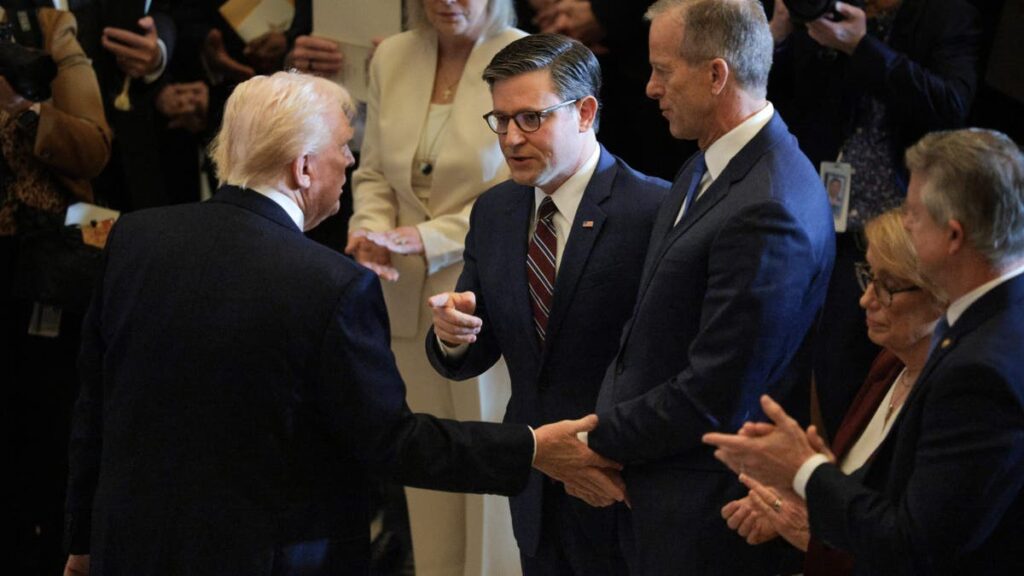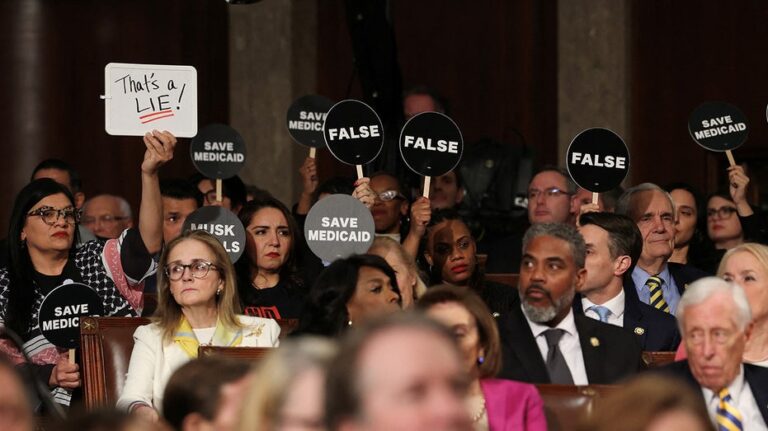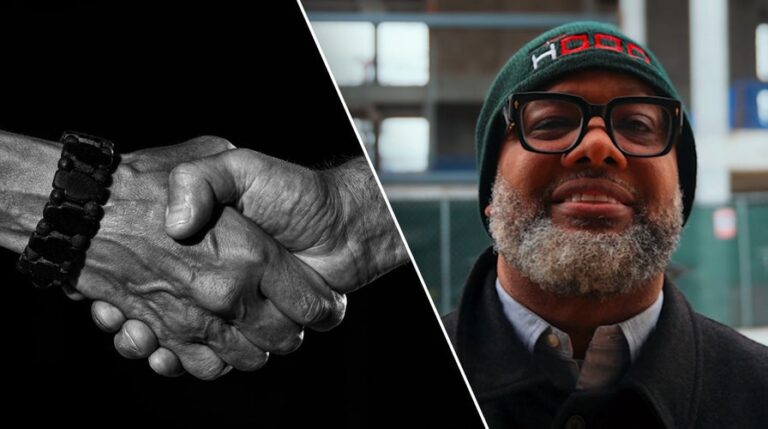
The government needs to raise money to expand and extend the Trump 2017 tax cuts, and there’s a way to do it without raising taxes on anyone.
Hear me out, members (and staffs) of the House Ways and Means Committee and Senate Finance Committee. Do not raise taxes on anyone, even those making a million or more a year. That should be a red line for Republicans.
But you need revenue to pay for extending and expanding the Trump 2017 tax cuts that powered the explosive growth of his first term before the Covid curtain came down. Here’s an option.
According to the Investment Company Institute, Americans had $8.9 trillion invested in 401(k)s and $15.2 trillion in IRAs in the third quarter of 2024. Let’s call it $22 trillion in yet-to-be-taxed money. (I suspect retirement funds held in 401(a) and 403(b) accounts are included in these numbers, so let’s stick with $22 trillion in untaxed retirement savings.)
GOP SENATORS BULLISH ON POST-EASTER ‘BIG, BEAUTIFUL’ BUDGET AGREEMENT
Not $24 trillion, because roughly $1.5 trillion of the retirement account amounts cited above are deposited in “Roth IRAs,” on which taxes have already been collected and within which funds grow tax-free. Funds in Roth IRAs can be withdrawn tax-free according to the rules governing those accounts under which the account holder must be 59 1/2 or using the money for a first home purchase.
Roth IRA contributions were taxed in the year they were treated as income, but they grow in those accounts tax-free. The savings in traditional 401(k)s and IRAs have not been taxed, have grown tax-free, and will only be taxed when their owners or their heirs withdraw the money.
What is needed is a “conversion incentive window.” Put one in the tax code for 2026.
These Roth 401(k) dollars don’t figure in any “conversion incentive window” provisions in a future tax code as they have already found their way to the tax-favored Roth accounts. But all the other tax-protected retirement account holders will quickly be assessing —and probably using— any fair opportunity to convert their savings into Roth IRAs provided the “conversion tax” isn’t too high.
Every year around tax time some older Americans receive suggestions that they “convert” their retirement holdings to Roth IRAs. It is perfectly legal to do, but difficult to figure out whether to do it. Thus, financial planners nudge their clients to at least make the calculations as best they can.
It sometimes makes sense for the non-Roth IRA saver to do so, but not often. Most older Americans will earn less as they age and thus pay lower taxes on the withdrawals when they are made, so they don’t convert. Some may believe taxes will increase by the time they retire, so they do. Others don’t really want to confront the grim math of actuarial tables, so they don’t do the calculations. So it is very difficult to calculate the eventual tax people will pay to the federal government on their retirement savings because, of course, we don’t know how long everyone will live or the future tax rates or if they intend to leave all or most of their 401/IRA savings to their heirs.
But there has to be an educated guess somewhere in the Congressional Budget Office (“CBO”) on how much the IRS will eventually collect from these $22 trillion in untaxed retirement savings, though that “estimate” is truly throwing a dart in the dark given the number of variables involved.
If, however, the House Ways and Means Committee and the Senate Finance Committee agree to adopt for next year a one-time “conversion window” in the reconciliation process that allows and taxes “conversions” of savings in traditional 401(k), 403(b) and IRA accounts into Roth IRA accounts, the revenue windfall in 2026 would be immense. Taxpayers would line up to pay that “conversion tax” if it was at 10% and would probably shy away if it was 25% or more.
If the conversion rate is, say, 15%, the income to the government should be much more than a trillion dollars and perhaps three times that amount, which would count as the “savings” the House and Senate have to “find” to keep all the promises made in the recently adopted budget. The key legislators, with an assist from CBO, can play with the conversion rates from 10% to 25% and still guarantee a windfall. That’s for the CBO and the tax code writers to figure out. But the concept? It’s as simple as the Kemp-Roth tax plan of long ago and would prove just as popular and growth inducing as that plan did when President Reagan largely adopted it as well.
CLICK HERE FOR MORE FOX NEWS OPINION
Some states with high income taxes will complain about such a provision as they fret over the loss of future income tax revenue, but savers are leaving their states for the low-to-no tax states anyway, and the SALT deduction increase is in this mix to begin with. States with high “state and local taxes” should accept a win on the SALT deduction increasing and simply shut up on the theoretical loss in tax revenues years down the road, a “loss” of tax revenue they can’t count on in any event.
The biggest obstacle to this “window” opening is that it has no lobby behind it, no well-heeled K-Street bigs pushing for it as there is no lobby for people who save for their retirement.
But there is a chasm between the tax and spending blueprints of the Senate GOP and the House GOP. A “conversion window” is the bridge they need and a sponsor of it will enter the Kemp-Roth Hall of Fame. Rather than rattle every bone inside the Beltway by grappling with entitlements except around the margins where “waste, fraud and abuse” live, start asking CBO for revenue estimates on the 401(k)/IRA conversion window.
Just do it, Congress. Not every idea needs to be advanced by lobbyists.
Hugh Hewitt is a Fox News contributor, and host of “The Hugh Hewitt Show,” heard weekday mornings 6am to 9am ET on the Salem Radio Network, and simulcast on Salem News Channel. Hugh wakes up America on over 400 affiliates nationwide, and on all the streaming platforms where SNC can be seen. He is a frequent guest on the Fox News Channel’s news roundtable hosted by Bret Baier weekdays at 6pm ET. A son of Ohio and a graduate of Harvard College and the University of Michigan Law School, Hewitt has been a Professor of Law at Chapman University’s Fowler School of Law since 1996 where he teaches Constitutional Law. Hewitt launched his eponymous radio show from Los Angeles in 1990. Hewitt has frequently appeared on every major national news television network, hosted television shows for PBS and MSNBC, written for every major American paper, has authored a dozen books and moderated a score of Republican candidate debates, most recently the November 2023 Republican presidential debate in Miami and four Republican presidential debates in the 2015-16 cycle. Hewitt focuses his radio show and his column on the Constitution, national security, American politics and the Cleveland Browns and Guardians. Hewitt has interviewed tens of thousands of guests from Democrats Hillary Clinton and John Kerry to Republican Presidents George W. Bush and Donald Trump over his 40 years in broadcast, and this column previews the lead story that will drive his radio/ TV show today.






